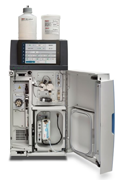We talked with Dr Jeffrey Rohrer, Director of Applications for ion chromatography (IC) products at Thermo Fisher Scientific for his thoughts on the evolving role of IC in regulated pharmaceutical analysis...
What’s been the biggest change in the use of ion chromatography for regulated pharmaceutical analysis in your career so far? 15-20 years ago ion chromatography was little to no part of the USP-NF (United States Pharmacopeia and National Formulary), and if you looked at a monograph for a drug substance or drug product your chances of finding an IC method would be almost zero. This has now changed as part of the USP modernization effort. Even before the 'official' modernization effort began there was a stimulus to get more chromatography methods throughout the USP or the ‘book’ as it’s often referred to, and some of those methods were ion chromatography methods. That’s now really ramped up over the last 5-7 years, and there’s been an almost exponential increase in the number of methods that use ion chromatography.
15-20 years ago ion chromatography was little to no part of the USP-NF (United States Pharmacopeia and National Formulary), and if you looked at a monograph for a drug substance or drug product your chances of finding an IC method would be almost zero. This has now changed as part of the USP modernization effort. Even before the 'official' modernization effort began there was a stimulus to get more chromatography methods throughout the USP or the ‘book’ as it’s often referred to, and some of those methods were ion chromatography methods. That’s now really ramped up over the last 5-7 years, and there’s been an almost exponential increase in the number of methods that use ion chromatography.

Why has the number of ion chromatography methods in the USP-NF increased?
That’s in part because IC itself has matured a lot during that period. There’s a lot of new stationary phases, new columns for better separation, with varying capacities. Capacity is the ability of the column to bind a lot of material – this is very important if you’re trying to find a small amount of something in the presence of a large amount of something else. That relates to some of the tests in the USP-NF – limit tests – where you’re looking for impurities that maybe aren’t very good for you. If you took that same medication over and over again you would accumulate that impurity in your body. Some of those impurities are ionic so IC has been applied to that. Previously it might have been impossible to analyse these compounds, but with the column technology available today it’s possible. Now that you have these good phases and systems that are easier to use the analyst is more likely to look at ion chromatography and bring that type of technology into the laboratory.
There are also environmental issues to consider, even in labs where everyone is trying to reduce their consumption and waste – ion chromatography rarely uses organic solvents so you don’t have to purchase acetonitrile, you don’t have to purchase methanol and more importantly you don’t have to dispose of them – that costs money. These are some of the things that have led to this change in ion chromatography methods.
How have ion chromatography systems evolved to meet the needs of pharmaceutical customers?
Ion chromatography itself has got easier to do because it’s more automated – that’s in part due to developments in detection, for example, for addressing suppression with a technology we call 'suppressed conductivity'. The IC system now can also create its own mobile phases (eluents), through electrolysis.
 We have introduced a new IC system that’s well suited to the pharmaceutical industry – the Integrion – it can come with the suppressed conductivity detector for standard IC, or it can be equipped with an electrochemical detector to perform high-performance anion-exchange chromatography with pulsed amperometric detection (HPAE-PAD), which we can use for carbohydrate analysis. Carbohydrate analysis by HPAE-PAD is one of the methods used in the 'Heparin Sodium' monograph for organic impurities. It’s also used for 'Aminoglycoside' analysis for certain monographs.
We have introduced a new IC system that’s well suited to the pharmaceutical industry – the Integrion – it can come with the suppressed conductivity detector for standard IC, or it can be equipped with an electrochemical detector to perform high-performance anion-exchange chromatography with pulsed amperometric detection (HPAE-PAD), which we can use for carbohydrate analysis. Carbohydrate analysis by HPAE-PAD is one of the methods used in the 'Heparin Sodium' monograph for organic impurities. It’s also used for 'Aminoglycoside' analysis for certain monographs.
Another benefit to the pharmaceutical industry is that this system has Viper fittings that we at Thermo Fisher Scientific already use on our HPLC systems. These are easy, low dead volume or no dead volume fittings that can be fitted by hand – that’s great ease of use and it gets great peak shapes. In addition, we have standard eWorkflow methods that can be downloaded onto a system so the customer, the analyst, doesn’t have to develop a method for something that’s already been done. That saves time, and obviously eliminates mistakes. The system is also capable of high pressure IC in terms of eluent generation.
What benefits does eluent generation technology offer to the pharmaceutical industry?
So all the analyst has to do is add water to the system. That’s highly automated, highly attractive to pharmaceutical companies, especially pharmaceutical companies that are based throughout the world. They can develop a method in one country, say the UK, and then transfer that method to another country, say India. Or it could be developed in India and transferred to the USA, China or wherever, with great reproducibility. You don’t have to worry about how this mobile phase has been made, what is the pH, is the purity of the organic solvent good enough etc.
Ion chromatography can now run at 6000 PSI. We haven't been able to do that with eluent generation because of certain limitations, but advances in technology now allow us to perform eluent generation up to 5000 PSI – what this means is that we can make shorter methods with smaller particle size columns.
In part 2 we'll discuss column technology and what the future holds for ion chromatography and pharmaceutical analysis...
 Dr Jeffrey Rohrer joined Thermo Fisher Scientific as part of Dionex 28 years ago. He’s worked as an applications chemist and R&D chemist, and about 20 years ago he began managing applications labs in ion chromatography, HPLC, and extraction to produce application documents. Currently he is Director of Applications development for Dionex products, comprising ion chromatography and part of IC called HPAE-PAD.
Dr Jeffrey Rohrer joined Thermo Fisher Scientific as part of Dionex 28 years ago. He’s worked as an applications chemist and R&D chemist, and about 20 years ago he began managing applications labs in ion chromatography, HPLC, and extraction to produce application documents. Currently he is Director of Applications development for Dionex products, comprising ion chromatography and part of IC called HPAE-PAD.




